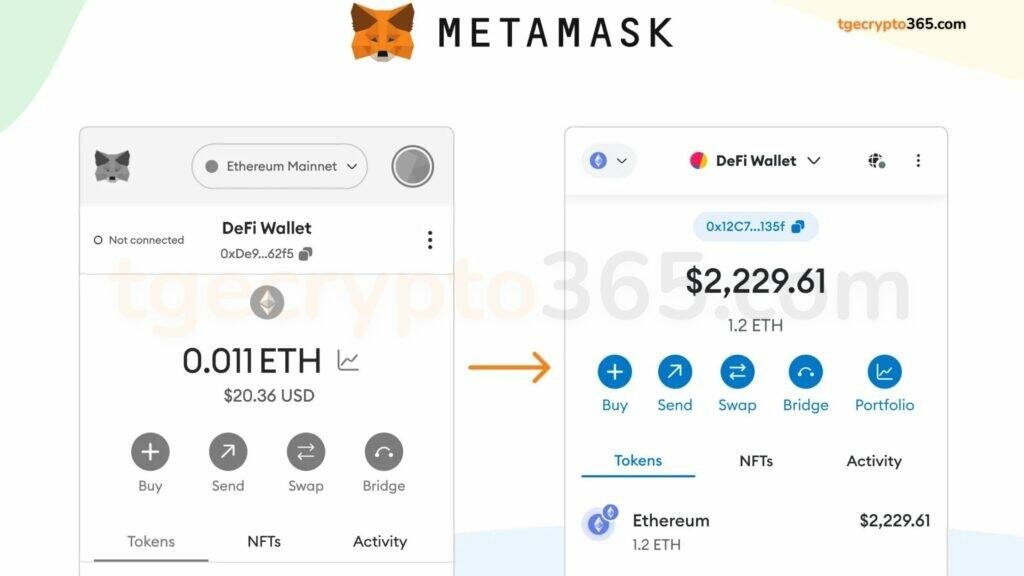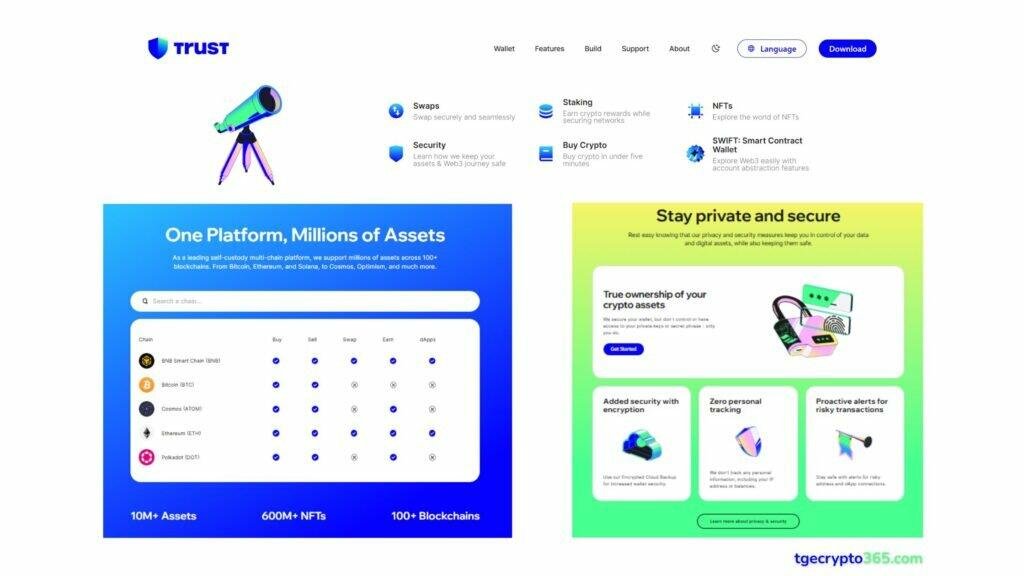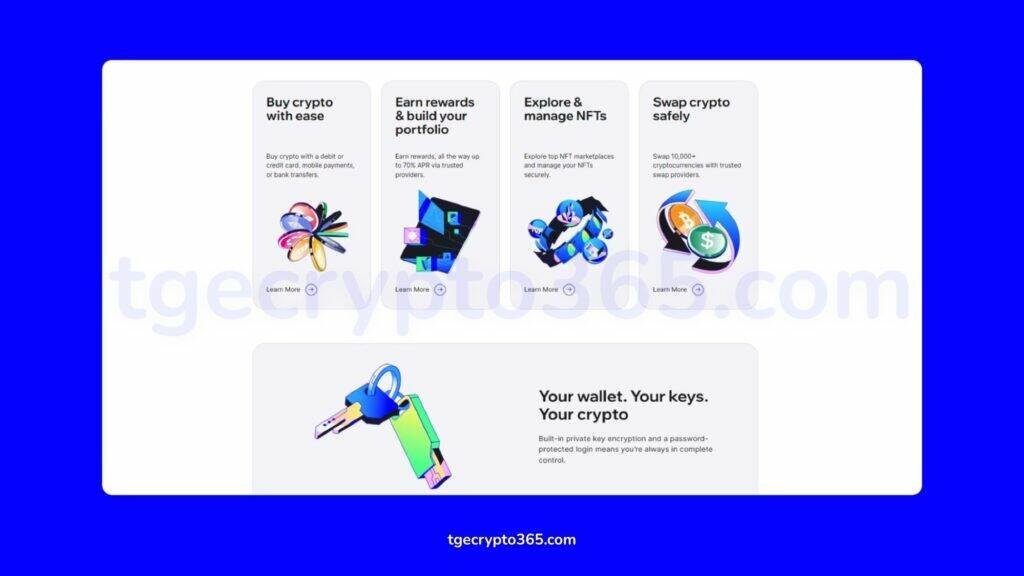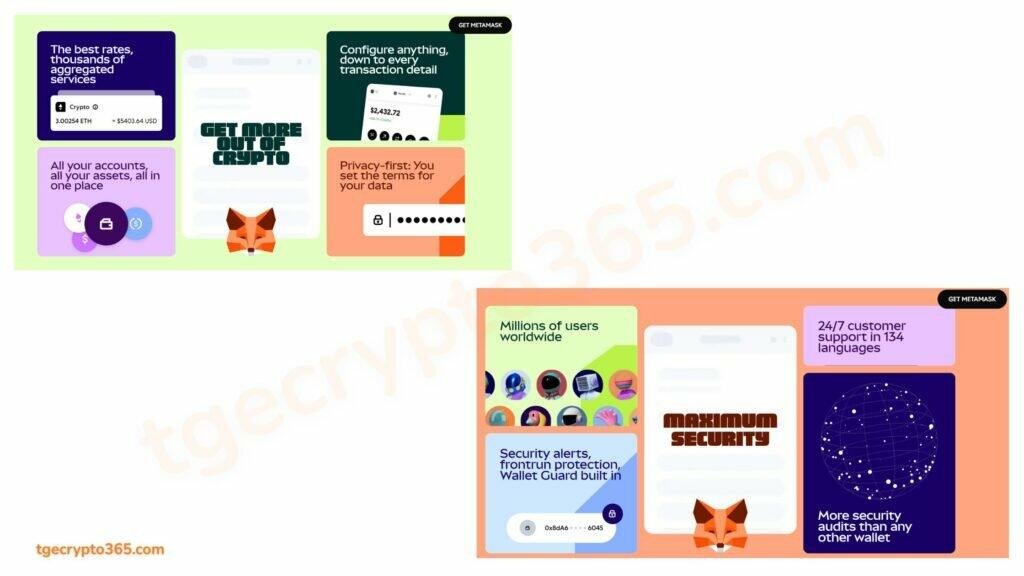MetaMask vs Trust Wallet: Are you ready to take your crypto journey to the next level?
🚀 As we approach 2025, the battle between MetaMask vs Trust Wallet is heating up, leaving crypto enthusiasts wondering which wallet reigns supreme.
Whether you’re a seasoned trader or just dipping your toes into the world of digital assets, choosing the right wallet can make or break your crypto experience.
Imagine having a secure, user-friendly gateway to manage your cryptocurrencies, interact with DApps, and explore the ever-expanding Web3 landscape.
Both MetaMask and Trust Wallet offer these possibilities, but which one truly fits your needs?
From UI/UX to supported assets, security features to transaction fees, we’ll dive deep into every aspect of these popular wallets. You’ll discover how they stack up against each other and uncover the hidden gems that could make all the difference in your crypto journey.
In this ultimate comparison, we’ll explore the ins and outs of MetaMask and Trust Wallet, helping you make an informed decision for your crypto future.
Get ready to unlock the potential of blockchain technology as we guide you through user interfaces, supported networks, security measures, and much more.
Let’s embark on this exciting journey to find the perfect wallet for your 2025 crypto adventures! 💼✨
Overview of MetaMask vs Trust Wallet
Brief history and background
MetaMask and Trust Wallet are two prominent players in the cryptocurrency wallet space, each with its unique origin and development path.
MetaMask, launched in 2016, initially focused on the Ethereum ecosystem and EVM-compatible chains. It quickly gained popularity among advanced users for its browser extension functionality.
Trust Wallet, on the other hand, was acquired by Binance in November 2017, becoming its official decentralized wallet. This acquisition positioned Trust Wallet as a mobile-first application with broad blockchain support.
Core functionalities and features
Both wallets offer essential features for managing digital assets, but with distinct focuses:
| Feature | MetaMask | Trust Wallet |
|---|---|---|
| Supported Assets | 500,000+ tokens | 4.5 million+ coins |
| Primary Networks | Ethereum and EVM-compatible | 70+ blockchains |
| User Interface | Browser extension and mobile app | Mobile-first application |
| Swap Functionality | Built-in token swap with 0.875% fee | Native swaps with no additional fees |
| DApp Integration | Strong focus on Ethereum-based DApps | Access to various DApps across multiple chains |
| Staking Options | Limited, primarily for Ethereum | Native staking for various assets |
| Hardware Wallet Integration | Supported | Not mentioned |
Target user base and market position
You’ll find that MetaMask caters primarily to advanced users deeply engaged in the Ethereum ecosystem and DeFi applications. Its browser extension makes it particularly beneficial for desktop users interacting with Ethereum-based DApps.
However, you might find its setup more complex for non-Ethereum networks.
Trust Wallet, in contrast, targets a broader audience with its user-friendly interface and extensive blockchain support.
You’ll appreciate its simplicity if you’re a beginner or if you prefer a mobile-centric experience. It’s ideal if you want to manage a diverse portfolio of assets across multiple blockchains without complicated setups.
Both wallets are non-custodial, giving you full control over your private keys and assets. They also share similar security features, protecting you from phishing attacks and offering seed phrase recovery options.
Now that we have covered the overview of MetaMask and Trust Wallet, including their history, core features, and target users, let’s delve into the next crucial aspect: User Interface and Experience.
This will give you a clearer picture of how these wallets differ in terms of usability and accessibility.
User Interface and Experience
Now that we’ve covered the overview of MetaMask and Trust Wallet, let’s dive into their user interfaces and experiences, which play a crucial role in how you interact with these popular cryptocurrency wallets.
MetaMask’s browser extension and mobile app
MetaMask offers both a browser extension and a mobile app, providing you with flexibility in accessing your wallet. However, the user experience has some room for improvement:
- Onboarding process: You might find the initial setup overwhelming due to excessive text and repetitive information. There’s no option to skip for experienced users, which can be frustrating.
- Password creation: The lack of guidance during password creation may leave you unsure about the security requirements.
- Home page layout: You may encounter a cluttered sidebar that complicates navigation and prioritizes browser functions over wallet features.
To enhance your experience, MetaMask is working on several improvements:
| Proposed Enhancements | Benefits |
|---|---|
| Dark mode | Better accessibility |
| Improved visual hierarchy | Easier navigation |
| Password security checklist | Stronger account protection |
| Bottom navigation bar | Quicker access to features |
| Privacy icon | Option to hide balances |
| Share button | Easy sharing of wallet addresses |
Trust Wallet’s mobile-first approach
Trust Wallet focuses primarily on mobile users, which may be more convenient if you prefer managing your crypto on-the-go.
While specific details about Trust Wallet’s interface aren’t provided in the reference content, it’s worth noting that mobile-first approaches often prioritize simplicity and ease of use.
Ease of use for beginners vs. advanced users
Both wallets cater to different user levels, but they face challenges in balancing functionality:
-
For beginners:
- MetaMask’s complex interface may be overwhelming
- Lack of clear instructions for adding tokens or connecting to web3 sites
-
For advanced users:
- MetaMask offers more features but at the cost of a cluttered interface
- Navigation issues and inconsistent behaviors may frustrate experienced users
To improve usability for all levels, both wallets could consider:
- Streamlining the onboarding process
- Providing clearer instructions for common tasks
- Implementing better feedback systems for transactions and wallet sync status
- Simplifying the explanation of gas fees and other complex concepts
As we transition to discussing supported assets and blockchain networks, it’s important to note that the user interface plays a crucial role in how easily you can manage different cryptocurrencies and interact with various blockchain ecosystems.
Supported Assets and Blockchain Networks
Now that we’ve explored the user interface and experience of MetaMask vs Trust Wallet, let’s dive into their supported assets and blockchain networks.
This aspect is crucial in determining which wallet best suits your crypto needs.
A. Trust Wallet’s multi-chain support (70+ blockchains)
Trust Wallet stands out with its impressive multi-chain support, accommodating over 70 blockchains.
This extensive coverage allows you to manage a diverse cryptocurrency portfolio within a single app. Here’s what you can expect:
- Support for 250,000+ cryptocurrencies
- Compatibility with major networks like Bitcoin, Ethereum, and Solana
- NFT storage and transactions across supported networks
- Integration with decentralized exchanges (DEXs) for easy trading
With Trust Wallet, you’re not limited to a single blockchain ecosystem, giving you the flexibility to explore various crypto assets and projects.
B. MetaMask’s focus on Ethereum and ERC-20 tokens
In contrast to Trust Wallet’s broad support, MetaMask primarily caters to Ethereum and EVM-compatible networks. While this might seem limiting, it offers specialized features for Ethereum users:
- Full support for Ethereum and ERC-20 tokens
- Seamless interaction with Ethereum-based decentralized applications (dapps)
- Option to use wrapped tokens for non-Ethereum cryptocurrencies
| Feature | Trust Wallet | MetaMask |
|---|---|---|
| Supported blockchains | 70+ | Ethereum and EVM-compatible |
| Asset range | 250,000+ cryptocurrencies | Ethereum and ERC-20 tokens |
| NFT support | Yes, across multiple chains | Yes, Ethereum-based |
C. NFT and DApp integration capabilities
Both wallets offer NFT and DApp integration, but with different approaches:
-
Trust Wallet:
- Supports NFTs across multiple blockchains
- Provides a user-friendly interface for NFT management
- Enables interaction with various DApps, including DeFi platforms
-
MetaMask:
- Excels in Ethereum-based NFT and DApp interactions
- Offers a robust DApp browser extension
- Facilitates seamless connections to thousands of decentralized applications
While Trust Wallet provides broader blockchain support, MetaMask’s specialized focus on Ethereum makes it a preferred choice for users deeply involved in the Ethereum ecosystem.
With this understanding of supported assets and blockchain networks, we’ll next explore the security features and measures implemented by both wallets to protect your digital assets.
Security Features and Measures
Now that we’ve covered the supported assets and blockchain networks, let’s dive into the critical aspect of security features and measures for both MetaMask and Trust Wallet.
Private key management and recovery options
When it comes to securing your digital assets, both MetaMask and Trust Wallet offer robust private key management and recovery options:
- Seed phrase: Both wallets utilize a 12-word backup seed phrase for account recovery.
- Biometric authentication: You can enhance security with fingerprint or face recognition.
- Hardware wallet integration: For added protection, you can connect your hardware wallets to both MetaMask and Trust Wallet.
Here’s a comparison of their security features:
| Feature | MetaMask | Trust Wallet |
|---|---|---|
| Noncustodial | Yes | Yes |
| Seed phrase length | 12 words | 12 words |
| Biometric auth | Yes | Yes |
| Hardware wallet support | Yes | Yes |
Trust Wallet’s security vulnerabilities and recent breach
While Trust Wallet has been a popular choice for many users, it’s important to note its recent security issues:
- Trust Wallet experienced a significant security breach recently.
- As a decentralized wallet, it remains susceptible to online threats.
- The wallet’s connection to Binance may raise concerns for some users regarding independence.
MetaMask’s track record against hacks
MetaMask has demonstrated a stronger resilience against major hacks:
- More security audits conducted than any other wallet.
- Robust security alerts and wallet protection features.
- Open-source nature allows for community scrutiny and faster vulnerability detection.
However, it’s crucial to remember that both wallets have their vulnerabilities, and your security largely depends on how you manage your private keys and interact with decentralized applications.
With security measures in mind, you’ll want to consider how these wallets integrate with various decentralized applications (DApps) to enhance your overall crypto experience.
In the next section, we’ll explore the integration capabilities of MetaMask vs Trust Wallet with DApps, which will help you understand how these security features come into play when interacting with the broader blockchain ecosystem.
Integration with Decentralized Applications (DApps)
Now that we’ve explored the security features of both wallets, let’s dive into how MetaMask and Trust Wallet integrate with decentralized applications (DApps), a crucial aspect of your Web3 experience.
MetaMask’s robust DApp connectivity
MetaMask excels in providing seamless integration with DApps, especially on desktop platforms. You’ll find:
- Easy connection to thousands of decentralized applications
- Support for Ethereum and EVM-compatible networks
- A user-friendly interface for interacting with DApps
MetaMask’s Wallet API serves as the foundation for web DApp interactions, allowing you to:
- Access user accounts
- Send transactions
- Sign messages
- Monitor account and network changes
For developers creating cross-platform applications, the MetaMask SDK offers additional features like mobile deeplinking and QR code connections.
Trust Wallet’s expanding DApp ecosystem
While Trust Wallet may not have the same level of desktop integration as MetaMask, it offers:
- Out-of-the-box support for multiple blockchains
- A user-friendly mobile experience for DApp interactions
- Broader token support across different networks
Trust Wallet’s versatility makes it an excellent choice if you’re looking to engage with various networks without complex setups.
User experience when interacting with DApps
Your experience interacting with DApps can vary depending on the wallet you choose:
| Feature | MetaMask | Trust Wallet |
|---|---|---|
| Desktop DApp interaction | Excellent | Good |
| Mobile DApp experience | Good | Excellent |
| NFT management | Ethereum-focused | Multi-chain support |
| Staking capabilities | Limited (primarily Ethereum) | Various assets supported |
With MetaMask, you’ll find it easier to connect to DApps on desktop, making it ideal if you’re deeply involved in Ethereum DeFi.
Trust Wallet, on the other hand, offers a more streamlined mobile experience and better multi-chain support for DApp interactions.
As you explore the world of DApps, remember that both wallets allow you to buy, sell, swap, send, and receive various cryptocurrencies.
You can also engage in activities like installing games, dropping NFTs, and even managing your cryptocurrency taxes directly through these wallets.
With this understanding of DApp integration, next, we’ll examine the transaction fees and customization options offered by both MetaMask vs Trust Wallet, which will further help you decide which wallet best suits your needs.
Transaction Fees and Customization
Now that we’ve explored how MetaMask and Trust Wallet integrate with decentralized applications, let’s dive into the crucial aspect of transaction fees and customization options offered by these popular crypto wallets.
MetaMask’s customizable gas fees
MetaMask provides you with the flexibility to customize gas fees, giving you more control over your transactions. Here’s what you need to know:
- You can adjust gas fees based on network congestion and transaction urgency
- MetaMask offers three preset options: slow, average, and fast
- Advanced users can manually set their preferred gas price
However, it’s important to note that MetaMask charges a 0.875% service fee on token swaps, which is an additional cost to consider when using this wallet.
Trust Wallet’s fee structure
Trust Wallet takes a different approach to transaction fees:
- No swap fees are imposed by Trust Wallet itself
- You only pay the network gas fees for your transactions
- The wallet supports multiple blockchains, potentially offering lower-fee alternatives
This fee-free structure can be particularly attractive if you frequently perform token swaps or transactions across different networks.
Cost-effectiveness for different types of transactions
To help you understand which wallet might be more cost-effective for your needs, consider the following comparison:
| Transaction Type | MetaMask | Trust Wallet |
|---|---|---|
| Token Swaps | 0.875% fee + gas fees | Only gas fees |
| Single-chain transactions | Customizable gas fees | Standard gas fees |
| Multi-chain transactions | Limited support | Potentially lower fees due to multi-chain support |
| DApp interactions | Ethereum-focused | Supports multiple blockchains |
Your choice between MetaMask and Trust Wallet for cost-effectiveness will depend on:
- The types of transactions you perform most frequently
- Your preference for fee customization vs. a simpler fee structure
- The blockchains you primarily use for your crypto activities
With this understanding of transaction fees and customization options, you’re better equipped to choose the wallet that aligns with your financial strategy.
Next, we’ll explore the additional features and services offered by MetaMask and Trust Wallet, which can further influence your decision on which wallet best suits your needs.
Additional Features and Services
Now that we’ve covered transaction fees and customization, let’s explore the additional features and services offered by MetaMask and Trust Wallet.
These extras can significantly enhance your cryptocurrency management experience.
Trust Wallet’s built-in exchange and staking options
Trust Wallet goes beyond basic wallet functionality by offering you convenient built-in features:
- Exchange: You can easily swap cryptocurrencies directly within the app, saving you time and effort.
- Staking: Trust Wallet allows you to stake certain cryptocurrencies, potentially earning passive income on your holdings.
These integrated services make Trust Wallet a versatile choice for managing your digital assets across 70 different blockchains.
MetaMask’s multi-account management
MetaMask excels in organizing your Ethereum-based assets with its multi-account management feature:
- Create and manage multiple Ethereum accounts within a single wallet
- Easily switch between accounts for different purposes or projects
- Keep your personal and business transactions separate
This feature is particularly useful if you’re actively involved in various Ethereum-based applications or need to manage multiple portfolios.
Integration with external platforms and services
Both wallets offer integration capabilities, but they differ in their approach:
| Feature | Trust Wallet | MetaMask |
|---|---|---|
| DApp Integration | Supports decentralized platforms | Excels in DApp connectivity |
| Asset Range | Wide array of cryptocurrencies | Limited to Ethereum-based tokens |
| Wrapped Tokens | Not required for most assets | Needed for non-Ethereum cryptocurrencies |
MetaMask’s strength lies in its robust integration with Ethereum-based decentralized applications, making it the go-to choice if you’re heavily invested in the Ethereum ecosystem.
Trust Wallet, on the other hand, offers broader cryptocurrency support without the need for wrapped tokens.
With these additional features and services in mind, next, we’ll explore the community support and development aspects of both wallets, which play a crucial role in their ongoing improvement and user satisfaction.
Community Support and Development
Now that we’ve explored the additional features and services offered by MetaMask vs Trust Wallet, let’s delve into their community support and development aspects, which play a crucial role in the overall user experience.
Trust Wallet’s backing by Binance
Trust Wallet’s association with Binance, one of the largest cryptocurrency exchanges, provides users with a sense of security and reliability. While specific details about Trust Wallet’s community support are not mentioned in the reference content, it’s important to note that being backed by a major player in the crypto industry can potentially lead to robust support structures.
MetaMask’s open-source nature and developer community
MetaMask takes a different approach with its open-source nature, fostering a vibrant developer community. This collaborative environment allows for continuous improvement and innovation. The open-source model enables developers to contribute to the platform’s growth, potentially leading to faster feature development and bug fixes.
User support and responsiveness to issues
When it comes to user support, MetaMask offers a comprehensive system to address user concerns:
-
MetaMask Help Center: This serves as the primary resource for users seeking assistance. It features:
- A search function for easy access to articles
- Frequently asked questions
- Troubleshooting guides
- User guides for various features
-
Community Forum: Users can:
- Search existing posts for solutions
- Create new posts for unresolved issues
- Engage with other community members
-
Direct Support: For more personalized assistance, users can:
- Click the ‘Contact Support’ button on the MetaMask support website
- Use the conversation feature in knowledge base articles
Here’s a breakdown of the support channels and their features:
| Support Channel | Features |
|---|---|
| Help Center | Search function, FAQs, Guides |
| Community Forum | User discussions, Problem-solving |
| Direct Support | Personalized assistance, Agent interaction |
When contacting support, you should provide detailed information about your issue, including:
- Actions taken before the error occurred
- Reproducibility of the issue
- Networks and tokens involved
- Your MetaMask version and system specifications
It’s crucial to note that as a self-custodial wallet, MetaMask cannot:
- Reset passwords
- Reverse transactions
- Retrieve lost secret recovery phrases
With this comprehensive support system in place, MetaMask demonstrates a strong commitment to user assistance and issue resolution.
As we look towards the future outlook and potential developments of these wallets, it’s clear that their community support and development strategies will play a significant role in shaping their evolution and user adoption.
Future Outlook and Potential Developments
Now that we’ve explored the community support and development aspects of MetaMask vs Trust Wallet, let’s look ahead to the future of these popular cryptocurrency wallets.
Anticipated features and improvements
As we approach 2025, you can expect significant enhancements to MetaMask’s functionality:
- Smart Transactions: Improving transaction reliability and security, with a success rate of 99.995%.
- Gas Fee Simplification: By March 2025, you’ll be able to pay gas fees in any token you hold, eliminating the need for ETH.
- Multi-Chain Support: Native integration of Bitcoin (Q3 2025) and Solana (May 2025), expanding your ability to manage diverse assets.
| Feature | Release Date | Benefit |
|---|---|---|
| Smart Transactions | Ongoing | Enhanced security and reliability |
| Gas Fee in Any Token | March 2025 | Simplified transactions |
| Bitcoin Support | Q3 2025 | Native BTC management |
| Solana Support | May 2025 | First non-EVM chain integration |
Adapting to evolving blockchain technologies
MetaMask is positioning itself to stay ahead of the curve:
- Network Abstraction: You’ll experience easier transitions between different blockchain networks.
- CAIP-25 Multichain API: This will allow you to connect to multiple networks simultaneously, enhancing cross-network functionality.
- Programmable Accounts: You’ll have the power to define custom permissions and interactions without incurring transaction costs.
Addressing current limitations and user concerns
MetaMask is tackling existing challenges head-on:
- User Experience: A redesigned home screen will help you manage assets across various chains more efficiently.
- Security Enhancements: The new delegation framework will simplify granting permissions to other accounts, increasing your control over wallet security.
- Real-World Integration: The MetaMask Card, in collaboration with Mastercard, will allow you to spend your crypto at millions of vendors globally.
By focusing on these improvements, MetaMask aims to make your Web3 experience more accessible, secure, and interconnected.
As you navigate the evolving cryptocurrency landscape, these developments will empower you to manage your digital assets with greater ease and confidence.
As we’ve explored the key features and functionalities of MetaMask and Trust Wallet, it’s clear that both wallets offer unique advantages for cryptocurrency enthusiasts in 2025.
MetaMask shines with its seamless integration with decentralized applications and user-friendly browser extension, making it an excellent choice for those deeply involved in the Ethereum ecosystem.
Trust Wallet, on the other hand, impresses with its broader asset support, including Bitcoin, and its intuitive mobile interface for managing a diverse crypto portfolio.
Your choice between these two wallets ultimately depends on your specific needs and preferences. If you’re primarily focused on Ethereum-based transactions and DApp interactions, MetaMask might be your go-to option.
However, if you’re looking for a more versatile wallet that supports a wide range of cryptocurrencies and offers features like staking and interest earning, Trust Wallet could be the better fit.
Whichever you choose, remember to prioritize security by safeguarding your recovery phrases and staying informed about the latest developments in the rapidly evolving world of cryptocurrency wallets.
Frequently Asked Questions (FAQs):
Q: What are the main differences between MetaMask and Trust Wallet?
A: MetaMask is primarily for Ethereum and ERC-20 tokens, while Trust Wallet supports multiple blockchains. MetaMask is available as a browser extension and mobile app, whereas Trust Wallet is mobile-only.
Q: Which wallet is generally considered more user-friendly?
A: Trust Wallet is often seen as more user-friendly, especially for beginners, due to its simple interface and mobile-first approach. However, MetaMask’s browser extension can be more convenient for desktop users.
Q: Are there any wallets that offer features beyond what MetaMask provides?
A: Yes, wallets like Exodus and Atomic Wallet offer built-in exchange features and support for more cryptocurrencies compared to MetaMask.
Q: Is MetaMask a safe wallet to use?
A: MetaMask is generally considered safe when used correctly. It’s open-source, widely used, and regularly audited. However, users must follow security best practices to protect their assets.
Q: What factors should I consider when choosing the best crypto wallet?
A: Consider security features, supported cryptocurrencies, ease of use, compatibility with your devices, integration with exchanges, and community support when choosing a crypto wallet.
Q: Can I use both MetaMask and Trust Wallet simultaneously?
A: Yes, you can use both wallets simultaneously. Many users do this to take advantage of the unique features each wallet offers.
Q: How secure is Trust Wallet?
A: Trust Wallet is considered secure, with features like private key encryption and biometric authentication. However, no wallet is 100% safe, and users should always follow security best practices.
Q: Which wallet offers better security features?
A: Both MetaMask and Trust Wallet offer strong security features. MetaMask has the advantage of hardware wallet integration, while Trust Wallet offers a secure enclave for private keys on mobile devices.
Q: Does Trust Wallet charge fees for transactions?
A: Trust Wallet itself doesn’t charge fees, but you’ll need to pay network fees for transactions on the blockchain. These fees vary depending on the network and its current congestion.
Q: Which wallet is better for DeFi interactions?
A: MetaMask is often preferred for DeFi interactions, especially on Ethereum, due to its seamless integration with web3 dApps through its browser extension.
Disclaimer:
I am not a Financial Advisor. This content is for informational purposes only. Always consult a qualified professional before making financial decisions.










